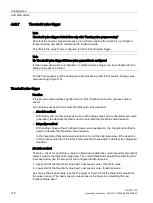
Configuration
4.22 Data points
TIM 1531 IRC
114
Operating Instructions, 02/2018, C79000-G8976-C468-02
The send buffer
The send buffer of the TIM is the memory for the individual values of data points that are
configured as an event. You will find the size of the send buffer in the manual of the relevant
module.
The capacity of the send buffer is divided up equally for all enabled partners.
If the connection to a communications partner is interrupted, the individual values of the
events are retained in the buffer. When the connection returns, the buffered values are sent.
The frame memory operates chronologically; in other words, the oldest frames are sent first
(FIFO principle).
If a frame was transferred to the communications partner, the transferred value is deleted
from the send buffer.
If frames cannot be transferred for a longer period of time and the send buffer is threatening
to overflow, the "Forced image mode" applies.
●
If the send buffer reaches a fill level of 90%, the module changes to the forced image
mode. New values from data points configured as an event are no longer added to the
send buffer but rather they overwrite older existing values in the image memory.
●
When the connection to the communications partner returns, the TIM changes back to the
send buffer mode if the fill level of the send buffer has fallen below 50%.
Saving the data point values
As a rule, the values of data points are stored in the image memory of the moodule and
transferred only when queried by the communications partner.
Events are also stored in the send buffer and can be transferred unsolicited.
Data points are configured as a static value or as an event using the "Type of transmission"
parameter (see below):
●
Static value (no event)
Static values are entered in the image memory (process image).
Static values correspond the following type of transmission "Transfer after call (class 0)".
●
Event
The values of data points configured as an event (triggered type of transmission) are also
entered in the image memory of the module. The values are also entered in the send
buffer.
Types of transmission and event classes
The following types of transmission are possible:
●
Transfer after call (class 0)
The current value of the data point is entered in the image memory. New values of a data
point overwrite the last stored value in the image memory.
After being called by the communications partner, the current value at this time is
transferred.
Содержание TIM 1531 IRC
Страница 262: ...Block library TeleControl ST7 5 7 Master copies TIM 1531 IRC 262 Operating Instructions 02 2018 C79000 G8976 C468 02 ...
Страница 302: ...Dimension drawings TIM 1531 IRC 302 Operating Instructions 02 2018 C79000 G8976 C468 02 ...
Страница 322: ...Documentation references 13 TIM 1531 IRC 322 Operating Instructions 02 2018 C79000 G8976 C468 02 ...
Страница 336: ...Glossary TIM 1531 IRC 336 Operating Instructions 02 2018 C79000 G8976 C468 02 ...






























